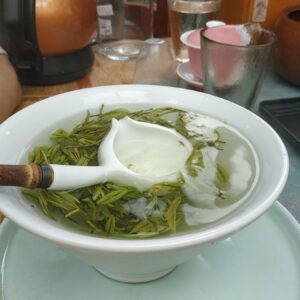Description
Matching Zhejiang Tea, Jiangsu Tea and Anhui Tea
To book our online workshops, just contact us in advance to book the time.
Jiangsu and Zhejiang tea culture has a long history, and scholars of all dynasties love tea and chant tea with various forms of literary and artistic works. Tea books written by all dynasties are indispensable to mention the tea here. Based on historical data, there are 67 tea producing areas in Tang Dynasty, 8 tea producing areas mentioned in Lu Yu’s <Tea Classic 茶经>, 43 states (counties), which are equivalent to 13 provinces today. In Tang Dynasty, there were more than 50 kinds of famous tea, most of which were steamed green cake tea, and a small amount of loose tea, including green tea and yellow tea. At that time, Guzhu Purple Bamboo Shoot tea from Wuyue (Jiangsu and Zhejiang) and Mengshan Purple Bamboo Shoot tea from Xishu (Sichuan) were the most popular products of the Tang emperor. Tang tribute tea producing house is located in Hutou Cliff on the side of Guzhu mountain, Changxing County, Zhejiang Province, which was founded in 770. It is the place to supervise the production of tribute tea Guzhu tea in Tang Dynasty, it is also the first tea processing factory in Chinese history. Read More
The areas not only produce good tea, but also has a complete tea culture system after thousands of years of development. The development of tea culture has an indissoluble bond with religion, especially Buddhism. The stories about literati, tea and Zen are well known. The spread of Jingshan tea and Jingshan tea banquet in Hangzhou in the Southern Song Dynasty to Japan is also closely related to learning Buddhism. According to legend, Qijia tea originated in the Southern Song Dynasty and is still spread to the West Lake tea town. At the beginning of summer, new tea comes into the market, and every family in the tea village brews new tea, which is accompanied by all kinds of fine fruits and cakes, and is sent to relatives and friends, so as to enhance the harmonious coexistence between neighbors.
The reason why Zhejiang has become a desirable tea culture tourist attraction is also due to the combination of the beauty of mountains and rivers and the rich history and culture of tea culture. Now, tea culture tourism has become an important part of leisure tourism in scenic spots such as West Lake, Qiandao Lake, Tianmu Mountain, Fuchun River and Jingshan. Since ancient times, there has been a saying that good tea should be matched with good water, while Hupao spring and Longjing spring are more famous in Hangzhou. Hui Mountian spring is now located in Xihui park at the foot of Hui mountain in the western suburb of Wuxi City, Jiangsu Province. Because Huishan spring water is famously good, so many ancient tea experts came to taste and discuss. Li Shen, a poet in the middle Tang Dynasty, “茶得此水,皆尽芳味也 once tea has this spring water, it will give off all its fragrance of this tea”. Read More
Contact us for an appointment:
Email: info@liu-tea-art.com
Tel.: 0049/51819010891
Address: Immserstr. 22 Alfeld (Leine) 31061 Germany












































